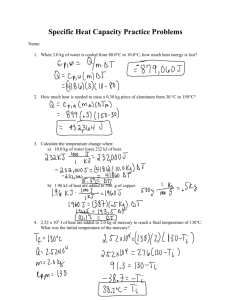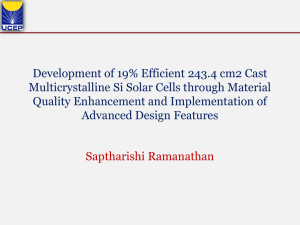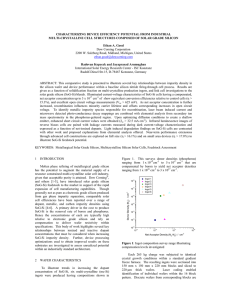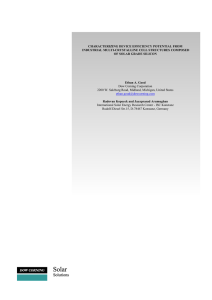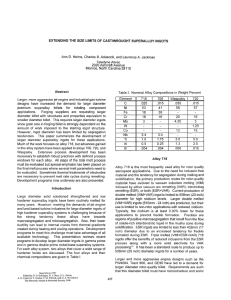JUNE AND
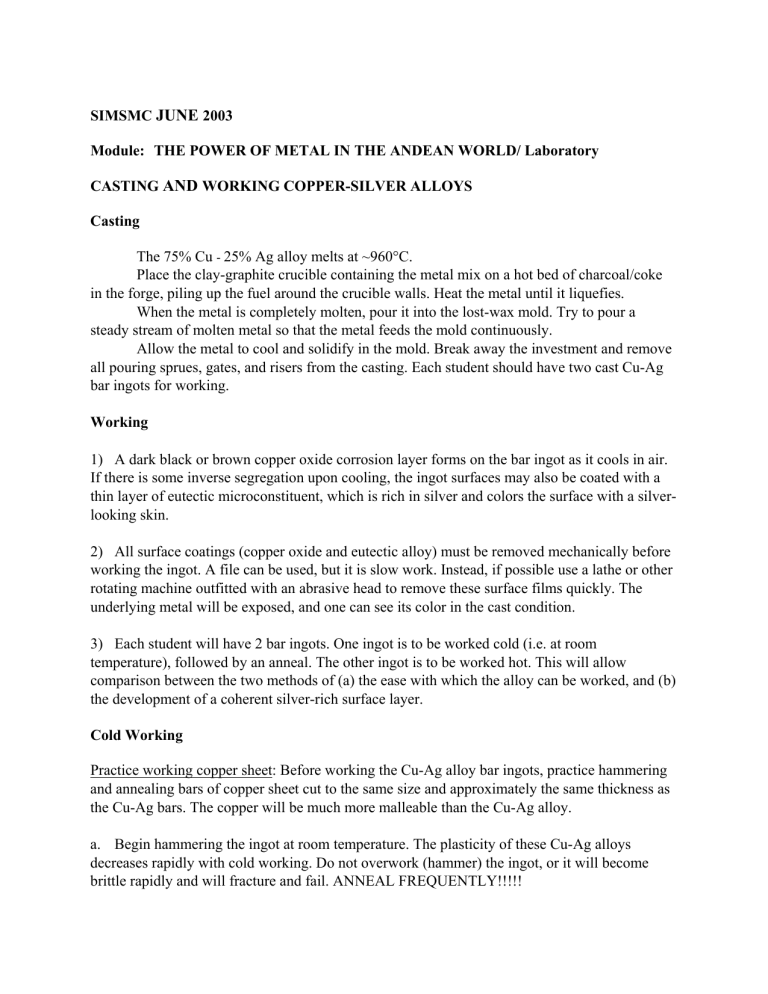
SIMSMC JUNE 2003
Module: THE POWER OF METAL IN THE ANDEAN WORLD/ Laboratory
CASTING AND WORKING COPPER-SILVER ALLOYS
Casting
The 75% Cu - 25% Ag alloy melts at ~960°C.
Place the clay-graphite crucible containing the metal mix on a hot bed of charcoal/coke in the forge, piling up the fuel around the crucible walls. Heat the metal until it liquefies.
When the metal is completely molten, pour it into the lost-wax mold. Try to pour a steady stream of molten metal so that the metal feeds the mold continuously.
Allow the metal to cool and solidify in the mold. Break away the investment and remove all pouring sprues, gates, and risers from the casting. Each student should have two cast Cu-Ag bar ingots for working.
Working
1) A dark black or brown copper oxide corrosion layer forms on the bar ingot as it cools in air.
If there is some inverse segregation upon cooling, the ingot surfaces may also be coated with a thin layer of eutectic microconstituent, which is rich in silver and colors the surface with a silverlooking skin.
2) All surface coatings (copper oxide and eutectic alloy) must be removed mechanically before working the ingot. A file can be used, but it is slow work. Instead, if possible use a lathe or other rotating machine outfitted with an abrasive head to remove these surface films quickly. The underlying metal will be exposed, and one can see its color in the cast condition.
3) Each student will have 2 bar ingots. One ingot is to be worked cold (i.e. at room temperature), followed by an anneal. The other ingot is to be worked hot. This will allow comparison between the two methods of (a) the ease with which the alloy can be worked, and (b) the development of a coherent silver-rich surface layer.
Cold Working
Practice working copper sheet: Before working the Cu-Ag alloy bar ingots, practice hammering and annealing bars of copper sheet cut to the same size and approximately the same thickness as the Cu-Ag bars. The copper will be much more malleable than the Cu-Ag alloy. a. Begin hammering the ingot at room temperature. The plasticity of these Cu-Ag alloys decreases rapidly with cold working. Do not overwork (hammer) the ingot, or it will become brittle rapidly and will fracture and fail. ANNEAL FREQUENTLY!!!!!
b. Anneal the ingot (worked piece) on a bed of hot charcoal or coal-and-coke. Keep the piece right on the bed of hot coals. Do not lift it up into the smoky zone of the flame or it will become coated with carbon. If that happens, the carbon can be cleaned mechanically with an abrasive
(such as Ajax and water). Heat the piece until it is a dull red. It will turn black quickly as the copper oxide scale forms on the surface. Allow it to heat until the red color is developed. Then remove it from the coals and either let it cool to room temperature or quench it in a water bath. c. Pickling: after each anneal, the copper oxide scale must be removed by dissolving it in a mild pickle. We have found that a 25-30% solution of sulfuric acid (at room temperature) works well.
Wash the piece well in water after it leaves the pickle, dry it, then resume hammering. ANNEAL
FREQUENTLY!!!!! d. As hammering progresses, small edge cracks will develop on the piece. These should not be allowed to grow too long or they will propagate into the body of the piece and cause it to fracture. At some point, remove the edge cracks mechanically. A file should work fine, or else a lathe-operated abrasive tool. e. Cold worked bar ingots generally develop a good silver surface layer after about 4 or 5 anneals.
Hot working a. Place the bar ingot on a bed of hot coals in the forge. Allow it to heat until it develops a dull red color. Remove it quickly from the coals and hammer it on a steel anvil. b. When hammering has ceased and the bar is at room temperature, pickle off the brown-black copper oxide scale in the sulfuric acid bath. Wash and dry the bar. c. Continue to hot work and pickle the bar until you achieve a desired shape and a coherent silver surface has formed.



